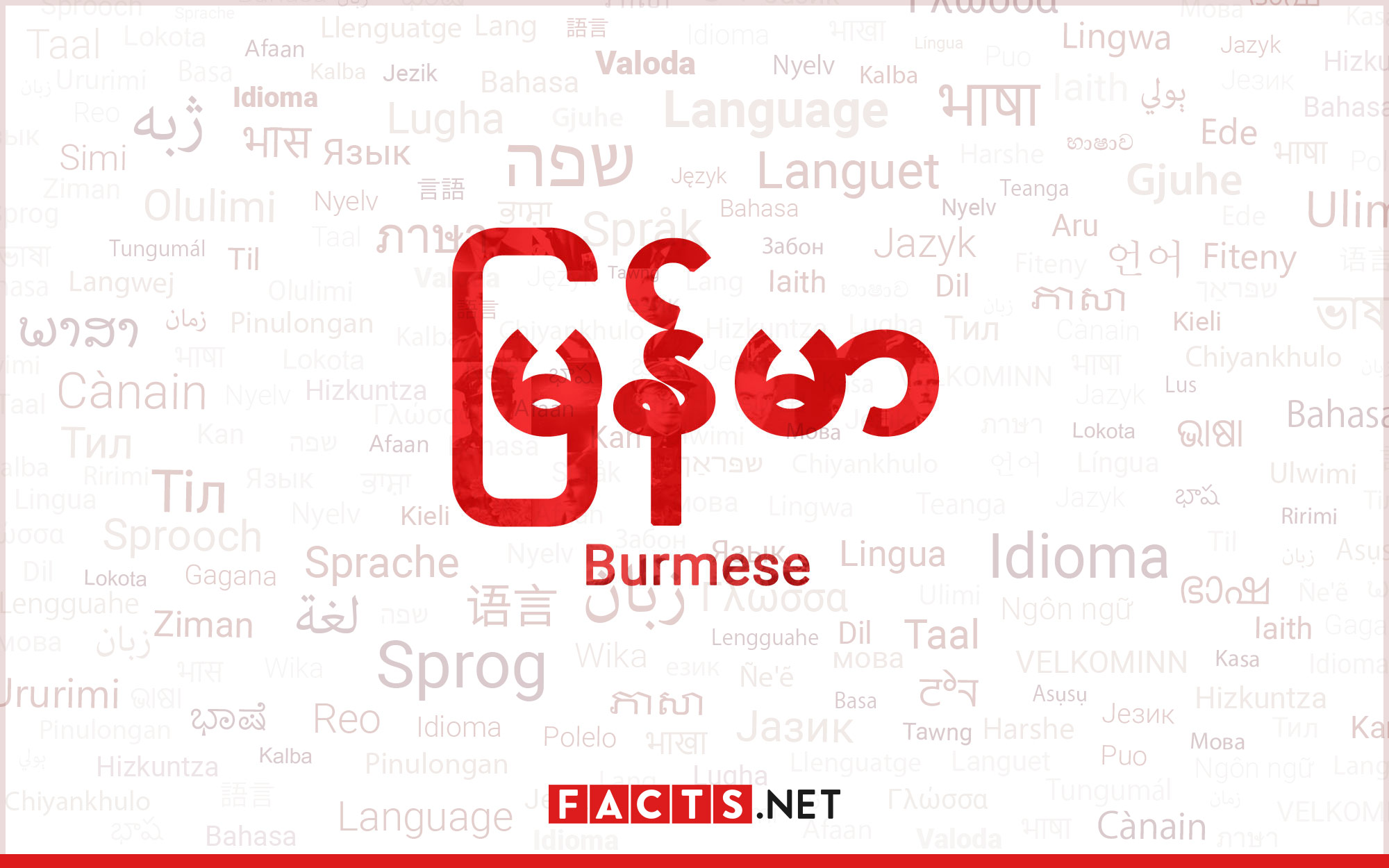
Burmese, also known as Myanmar language, is the official language of Myanmar and is spoken by over 30 million people worldwide. This fascinating language has a long and rich history, with influences from Pali, Mon, and other regional languages. While many may be familiar with some basic facts about Burmese, there are numerous surprising and interesting aspects of the language that are often overlooked.
In this article, we will delve into 18 surprising facts about Burmese that will not only enhance your understanding of the language but also captivate your curiosity. From its unique script to its grammatical intricacies and cultural significance, Burmese is a language deserving of our attention and appreciation. So, let’s embark on a journey of discovery and uncover some intriguing aspects of this vibrant linguistic treasure.
Key Takeaways:
- Burmese is a tonal language with a unique script, making it a gateway to understanding Myanmar’s rich cultural heritage and literature.
- Learning Burmese can open doors to connecting with the people of Myanmar and exploring the country’s diverse cultural tapestry.
The Burmese language belongs to the Sino-Tibetan language family.
Burmese is a member of the Sino-Tibetan language family, which includes other languages like Chinese, Tibetan, and Karen. This language family is one of the largest language families in the world, with numerous distinct languages and dialects.
Burmese is the official language of Myanmar.
As the official language of Myanmar, Burmese is spoken by the majority of the population in the country. It is used in government, education, media, and daily communication among the people of Myanmar.
Burmese has its own unique script called “Burmese Script”.
The Burmese script is an abugida script used for writing the Burmese language. It consists of curved and looped characters, derived from the ancient Brahmi script. The script is written from left to right, and each character represents a syllable.
Burmese has three tones that can change the meaning of words.
Tones play an important role in the pronunciation and meaning of words in Burmese. There are three main tones: high, low, and creaky. The tone can distinguish words that are otherwise spelled identically, adding complexity to the language.
The Burmese language has influences from Pali, Sanskrit, and Mon.
Throughout its history, the Burmese language has been influenced by various languages, including Pali, Sanskrit, and Mon. These influences can be seen in the vocabulary, grammar, and cultural aspects of the language.
Burmese has a unique honorific system.
In Burmese culture, the honorific system is deeply rooted. The language has specific words and phrases that are used to show respect and formality when addressing others based on age, social status, and relation. It reflects the hierarchical structure of society.
Burmese has borrowed words from English and other languages.
Like many other languages, Burmese has borrowed words from English and other languages in spheres such as technology, science, and popular culture. These loanwords have become integrated into the Burmese vocabulary over time
Burmese is tonal, meaning the pitch of a word can change its meaning.
Tones are an essential aspect of Burmese pronunciation. The pitch at which a word is spoken can change its meaning, even if the spelling remains the same. Mastering the correct tones is crucial for effective communication in Burmese.
The Burmese alphabet has 33 consonants and 12 vowels.
The Burmese alphabet consists of 33 consonant characters and 12 vowel characters. The syllabic structure of the language allows for various combinations of consonants and vowels to form words and phrases.
Burmese is the second most spoken language among the Sino-Tibetan languages.
With millions of speakers worldwide, Burmese is the second most spoken language among the Sino-Tibetan languages, following Mandarin Chinese. Its widespread usage contributes to its importance as a regional language.
Burmese has a rich literary tradition.
Burmese literature dates back centuries and includes various genres such as poetry, prose, and religious texts. Famous Burmese authors and poets have contributed greatly to the cultural heritage of Myanmar through their works.
Burmese has different levels of formality.
Burmese language has different levels of formality, ranging from casual language used among friends to highly formal language used in official and ceremonial settings. The choice of language level depends on the social context and the relationship between speakers.
Burmese culture and language are closely intertwined.
Language plays a significant role in the preservation and expression of Burmese culture. Traditional practices, literature, music, and art are deeply rooted in the Burmese language, creating a strong bond between cultural identity and language.
Burmese uses honorific particles to show respect.
In addition to honorific pronouns, Burmese also uses honorific particles or post-posed particles to convey respect or politeness. These particles are added to the end of sentences or phrases to indicate deference or politeness towards the listener.
Burmese is an important language for Buddhism.
Burmese is closely associated with Buddhism, which is the predominant religion in Myanmar. Many Buddhist scriptures and religious texts are written and recited in Burmese, making it a vital language for practicing Buddhists.
There are regional dialects of Burmese.
While Burmese is the national language of Myanmar, there are also regional dialects spoken in different parts of the country. These dialects may have slight variations in vocabulary, pronunciation, and grammar.
Learning Burmese can open doors to understanding Myanmar’s rich cultural heritage.
By learning Burmese, one can gain a deeper understanding of Myanmar’s rich cultural heritage, history, and traditions. It allows for a more meaningful connection with the people and the country when exploring its diverse cultural tapestry.
Burmese language is known for its politeness and honorific expressions.
Politeness and honorific expressions are highly valued in Burmese culture, and the language reflects this through its vocabulary and linguistic structures. Speaking Burmese with proper politeness and honorifics is seen as a sign of respect.
Overall, the 18 Surprising Facts About Burmese (Language) highlight the uniqueness and significance of this language within Myanmar and the wider linguistic landscape. From its tonal nature to its influence from various languages, the Burmese language encompasses a rich cultural heritage that continues to thrive. Whether one wishes to explore the literature, engage with the local community, or delve into the country’s history, learning Burmese can provide a gateway to a deeper understanding of Myanmar’s vibrant culture.
Conclusion
In conclusion, Burmese is a fascinating language with a rich history and unique characteristics. From its roots in the Sino-Tibetan language family to its distinctive script and tonal variations, Burmese offers a unique linguistic experience for both native speakers and language enthusiasts.
Learning Burmese can open doors to a vibrant culture and heritage that spans over centuries. Whether you’re planning to travel to Myanmar, delve into Burmese literature, or simply broaden your linguistic horizons, exploring the Burmese language can be a rewarding and enriching experience.
With its growing international recognition and the increasing accessibility of resources for learning, now is a great time to embark on a journey to explore and master the captivating world of Burmese.
FAQs
1. How many people speak Burmese?
Burmese is the official language of Myanmar and is spoken by the majority of the population, which is estimated to be around 54 million people.
2. Is Burmese difficult to learn?
Like any unfamiliar language, Burmese can pose some challenges for learners. However, with dedication and practice, it is definitely possible to grasp the basics and make progress in your proficiency.
3. Are there any similarities between Burmese and other languages?
Burmese shares some similarities with other languages in the Sino-Tibetan language family, such as Thai and Lao. However, it also has distinct characteristics that set it apart.
4. Can I learn Burmese online?
Yes, there are various online resources available for learning Burmese, including language courses, websites, and apps. These can provide a convenient and flexible way to study at your own pace.
5. Are there dialects in Burmese?
Yes, there are regional variations in Burmese, which can differ in terms of pronunciation, vocabulary, and grammar. However, the standard Burmese language, based on the Yangon dialect, is most widely understood and used.
Uncover the fascinating world of Burmese, a language steeped in history and cultural significance. From its unique script to its tonal system, Burmese offers a captivating journey for language enthusiasts. Explore the influence of Pali, Sanskrit, and Mon on this rich language, and discover how honorifics and formality levels shape Burmese communication. Dive into Myanmar's literary tradition and learn how Burmese intertwines with Buddhist practices. Whether you're curious about regional dialects or eager to unlock Myanmar's cultural heritage, this article will leave you yearning for more linguistic adventures, such as delving into the intriguing world of Burmese pythons.
Was this page helpful?
Our commitment to delivering trustworthy and engaging content is at the heart of what we do. Each fact on our site is contributed by real users like you, bringing a wealth of diverse insights and information. To ensure the highest standards of accuracy and reliability, our dedicated editors meticulously review each submission. This process guarantees that the facts we share are not only fascinating but also credible. Trust in our commitment to quality and authenticity as you explore and learn with us.


